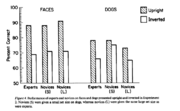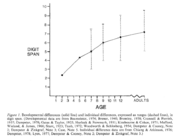心理實驗法第十七講:如何撰寫報告
出自KMU Wiki
(修訂版本間差異)
| 在2013年3月10日 (日) 22:18所做的修訂版本 (編輯) Sakurai (對話 | 貢獻) (→Sample (162-167)) ←上一個 |
在2013年6月16日 (日) 19:16所做的修訂版本 (編輯) (撤銷) Mi (對話 | 貢獻) 下一個→ |
||
| 第1行: | 第1行: | ||
| + | == 寫報告 == | ||
| + | |||
| + | APA's publication manual | ||
| + | writing style | ||
| + | effective communication | ||
| + | unbiased language | ||
| + | parts of manuscript | ||
| + | reporting data | ||
| + | 參考網頁 | ||
| + | http://apastyle.blogspot.com/ | ||
| + | |||
| + | |||
| == APA publication manual == | == APA publication manual == | ||
| 第38行: | 第50行: | ||
| ** Skillful writing | ** Skillful writing | ||
| ** Correct experiment | ** Correct experiment | ||
| - | ** | + | ** muddied writing的例子 |
| + | ** 中文閱讀,因為斷詞困難,英文閱讀則沒有這個困難,前者並沒有物理上的空間在詞間,後者則有,所以他們的界線是很不清楚的。 | ||
| + | |||
| * Reduce bias | * Reduce bias | ||
| 第125行: | 第139行: | ||
| ** 至少會用到描述統計 | ** 至少會用到描述統計 | ||
| ** 在心理學中統計很重要 | ** 在心理學中統計很重要 | ||
| - | ** | + | ** 如果自覺統計沒有學好的,請快點自修! |
| ==== Statistics ==== | ==== Statistics ==== | ||
| 第141行: | 第155行: | ||
| * Bar graphs | * Bar graphs | ||
| - | ** Case study | + | ** Case study |
| - | ** | + | ** 鄭若騏(2008)實驗一 |
| - | ** | + | *** 中文斷詞 |
| - | ** | + | *** 獨變項:漢字間距 |
| + | *** 依變項:每分鐘閱讀詞數 | ||
| + | |||
| + | 1 | ||
| + | |||
| ==== [[Image:Diamond-carey1986-fig4.png|thumb|right|Bar graphs]] ==== | ==== [[Image:Diamond-carey1986-fig4.png|thumb|right|Bar graphs]] ==== | ||
| 第153行: | 第171行: | ||
| ** 獨變項:norminal scale: bar graphs | ** 獨變項:norminal scale: bar graphs | ||
| ** 獨變項:interval/ ratio scale: histograms | ** 獨變項:interval/ ratio scale: histograms | ||
| - | * Case study | + | * Case study |
| - | ** | + | ** 鄭若騏(2008)實驗二 |
| - | ** | + | ** 詞彙判斷(獨變項:詞頻、位置;依變項:反應時間) |
| + | |||
| + | |||
| + | 2 | ||
| ==== [[Image:Dempster1981fig1.png|thumb|right|Histograms]] ==== | ==== [[Image:Dempster1981fig1.png|thumb|right|Histograms]] ==== | ||
| 第161行: | 第182行: | ||
| ==== Illustrations ==== | ==== Illustrations ==== | ||
| - | * Case studey | + | * Case studey 鄭若騏(2008)實驗二 |
| - | * | + | * 實驗程序 |
| - | + | ||
| + | 3 | ||
| <br> | <br> | ||
| + | * 圖 | ||
| + | ** case study 陳惠音(2009) | ||
| + | *** 凹臉錯覺 | ||
| - | + | 4 | |
| - | [[Image:Sands-etal1982fig9.png|thumb|right|fig 9.5]] | ||
| - | ==== | + | ==== 簡單名詞介紹 ==== |
| * 名詞 | * 名詞 | ||
| - | ** Running head | + | ** Running head 書楣標題 |
| - | ** Capitalized | + | ** Capitalized 大寫字體 |
| - | ** Centered | + | ** Centered 靠中對齊 |
| - | ** Indent | + | ** Indent 首行縮排 |
| - | ** Double space | + | ** Double space 雙行距 |
| - | ** Margins | + | ** Margins 邊界 |
| - | ** In press | + | ** In press 印刷中 |
| - | ** | + | ** Caption(圖)說明 |
| + | |||
| [http://wiki.kmu.edu.tw/index.php/%E5%BF%83%E7%90%86%E5%AF%A6%E9%A9%97%E6%B3%95 回到心理實驗法] | [http://wiki.kmu.edu.tw/index.php/%E5%BF%83%E7%90%86%E5%AF%A6%E9%A9%97%E6%B3%95 回到心理實驗法] | ||
在2013年6月16日 (日) 19:16所做的修訂版本
目錄 |
寫報告
APA's publication manual writing style effective communication unbiased language parts of manuscript reporting data 參考網頁 http://apastyle.blogspot.com/
APA publication manual
- Manuscript
- Expression of ideas
- Unbiased language
- APA editorial style
- Sample
Writing style
- 以下來自:Sternberg (2003) The psychology companion:
- Easy-to-read fashion
- Good scientific writing is creative
- Clear thinking make clear writing
- 正確的用語
- 不可用
- 大部分的情況
- 利用智力測驗
- 因為
- 多少才算是大部分的情況?
- 用何種智力測驗?
- 不可用
- 在文獻探討
- 邏輯說理過程
- 不必也不能搜尋所有相關的文獻
- 只要列出密切相關的文獻
- 由這些文獻以清楚的邏輯推論出問題所在
- 文法上
- 正確使用標點符號
- 最常見,一段只有一句話。一句超長的句子。
- 在一個句子中不要有太多的想法
- 也常見想要在一句話中描述所有的想法
- 有效的溝通
- Clear thinking
- Skillful writing
- Correct experiment
- muddied writing的例子
- 中文閱讀,因為斷詞困難,英文閱讀則沒有這個困難,前者並沒有物理上的空間在詞間,後者則有,所以他們的界線是很不清楚的。
- Reduce bias
- Appropriate level of specificity
- Sensitive to “labels”
- Acknowledge participation
- Sexual orientation
- Racial and ethic identity
- Disabilities
- Age
Parts of manuscript
- Title, author(s), and affiliation
- Abstract
- Introduction
- Method
- Subjects, Apparatus or Materials, Procedure
- Results
- Discussion (summary)
- References
Title
- Title
- 明確且簡短的題目
- XXXX在OOOO的效果
- XXXX代表獨變項
- OOOO代表依變項
- 明確且簡短的題目
Abstract
- 英文120 words之內
- 中文500字內
- Identify
- Problems
- Methods
- Results
Introduction
- Historical review
- 一句話中,不要多過一個研究結果
- 點出
- 重點在那裡
- 假設、實驗設計與問題間的關係
- 與先前研究間關係
- 學術重要性
Method
- 應包含
- Design
- 獨變項、依變項
- Participants
- Apparatus, materials
- Procedure
- Design
Results
- 應包含
- 實驗取得之資料
- 上述資料之統計結果
- 應用文字敘述上述兩項
- 必要時加入圖、表說明
Discussion
- 應包含
- 由結果推論出的
- 與先前研究間的異同
- 與自己假設間的異同
- 對未來的建議
References
- 要符合APA style
- 正文中所提的文獻必定要列出
- 在此列出的文獻,正文中明確指出引用在何處
- 最常犯的錯誤就是列了一堆文獻,但不知正文中何處引用過這些文獻
- 總之,正文與文獻列表要對應
Reporting data
- 要不要用統計?
- 至少會用到描述統計
- 在心理學中統計很重要
- 如果自覺統計沒有學好的,請快點自修!
Statistics
- Statistical studies
- Descriptive statistics
- Experimental studies
- Inferential statistics
- 工具
- SAS, SPSS
- Garbage in garbage out
- SAS, SPSS
Bar graphs
- Bar graphs
- Case study
- 鄭若騏(2008)實驗一
- 中文斷詞
- 獨變項:漢字間距
- 依變項:每分鐘閱讀詞數
1
Histograms
- 與bar graphs之使用時機之不同
- 獨變項:norminal scale: bar graphs
- 獨變項:interval/ ratio scale: histograms
- Case study
- 鄭若騏(2008)實驗二
- 詞彙判斷(獨變項:詞頻、位置;依變項:反應時間)
2
Illustrations
- Case studey 鄭若騏(2008)實驗二
- 實驗程序
3
- 圖
- case study 陳惠音(2009)
- 凹臉錯覺
- case study 陳惠音(2009)
4
簡單名詞介紹
- 名詞
- Running head 書楣標題
- Capitalized 大寫字體
- Centered 靠中對齊
- Indent 首行縮排
- Double space 雙行距
- Margins 邊界
- In press 印刷中
- Caption(圖)說明


